| Millennium |
|---|
| 1st millennium BC |
| Centuries |
| Decades |
| Years |
| Categories |
This article concerns the period 599 BC – 590 BC.
Contents
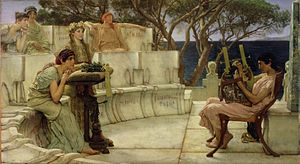
| Millennium |
|---|
| 1st millennium BC |
| Centuries |
| Decades |
| Years |
| Categories |
This article concerns the period 599 BC – 590 BC.


Chaldea was a small country that existed between the late 10th or early 9th and mid-6th centuries BC, after which the country and its people were absorbed and assimilated into the indigenous population of Babylonia. Semitic-speaking, it was located in the marshy land of the far southeastern corner of Mesopotamia and briefly came to rule Babylon. The Hebrew Bible uses the term כשדים (Kaśdim) and this is translated as Chaldaeans in the Greek Old Testament, although there is some dispute as to whether Kasdim in fact means Chaldean or refers to the south Mesopotamian Kaldu.
The 6th century BC started on the first day of 600 BC and ended on the last day of 501 BC.

The 7th century BC began the first day of 700 BC and ended the last day of 601 BC.

Babylonia was an ancient Akkadian-speaking state and cultural area based in the city of Babylon in central-southern Mesopotamia. It emerged as an Akkadian populated but Amorite-ruled state c. 1894 BC. During the reign of Hammurabi and afterwards, Babylonia was retrospectively called "the country of Akkad", a deliberate archaism in reference to the previous glory of the Akkadian Empire. It was often involved in rivalry with the older ethno-linguistically related state of Assyria in the north of Mesopotamia and Elam to the east in Ancient Iran. Babylonia briefly became the major power in the region after Hammurabi created a short-lived empire, succeeding the earlier Akkadian Empire, Third Dynasty of Ur, and Old Assyrian Empire. The Babylonian Empire rapidly fell apart after the death of Hammurabi and reverted to a small kingdom centered around the city of Babylon.
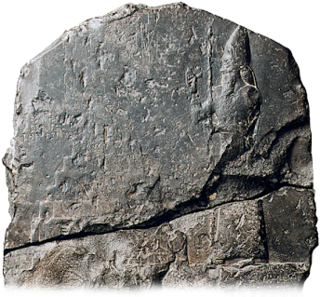
Nebuchadnezzar II, also spelled Nebuchadrezzar II, was the second king of the Neo-Babylonian Empire, ruling from the death of his father Nabopolassar in 605 BC to his own death in 562 BC. Historically known as Nebuchadnezzar the Great, he is typically regarded as the empire's greatest king. Nebuchadnezzar remains famous for his military campaigns in the Levant, for his construction projects in his capital, Babylon, including the Hanging Gardens of Babylon, and for the role he plays in Jewish history. Ruling for 43 years, Nebuchadnezzar was the longest-reigning king of the Babylonian dynasty. By the time of his death, he was among the most powerful rulers in the world.
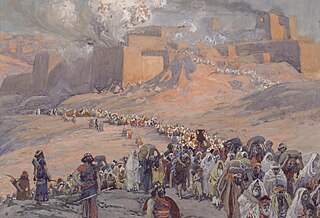
The Babylonian captivity or Babylonian exile was the period in Jewish history during which a large number of Judeans from the ancient Kingdom of Judah were forcibly relocated to Babylonia by the Neo-Babylonian Empire. The deportations occurred in multiple waves: After the siege of Jerusalem in 597 BCE, around 7,000 individuals were deported to Mesopotamia. Further deportations followed the destruction of Jerusalem and Solomon's Temple in 587 BCE.
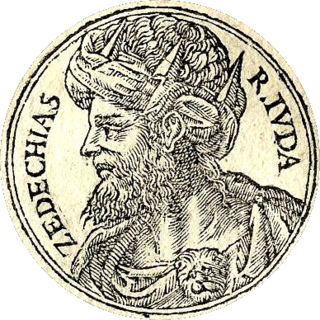
Zedekiah was the twentieth and final King of Judah before the destruction of Jerusalem by Nebuchadnezzar II of Babylon. His birth name was Mattaniah/Mattanyahu.

Necho II of Egypt was a king of the 26th Dynasty, which ruled from Sais. Necho undertook a number of construction projects across his kingdom. In his reign, according to the Greek historian Herodotus, Necho II sent out an expedition of Phoenicians, which in three years sailed from the Red Sea around Africa to the Strait of Gibraltar and back to Egypt. His son, Psammetichus II, upon succession may have removed Necho's name from monuments.

Jeconiah, also known as Coniah and as Jehoiachin, was the nineteenth and penultimate king of Judah who was dethroned by the King of Babylon, Nebuchadnezzar II in the 6th century BCE and was taken into captivity. He was the son and successor of King Jehoiakim, and the grandson of King Josiah. Most of what is known about Jeconiah is found in the Hebrew Bible. Records of Jeconiah's existence have been found in Iraq, such as the Jehoiachin's Rations Tablets. These tablets were excavated near the Ishtar Gate in Babylon and have been dated to c. 592 BCE. Written in cuneiform, they mention Jeconiah and his five sons as recipients of food rations in Babylon.
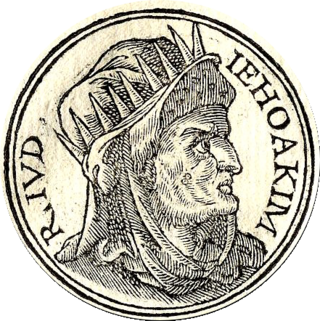
Jehoiakim, also sometimes spelled Jehoikim was the eighteenth and antepenultimate King of Judah from 609 to 598 BC. He was the second son of King Josiah and Zebidah, the daughter of Pedaiah of Rumah. His birth name was Eliakim.

Amel-Marduk, also known as Awil-Marduk, or under the biblical rendition of his name, Evil-Merodach Hebrew: אֱוִיל מְרֹדַךְ, romanized: əwil məroḏaḵ), was the third emperor of the Neo-Babylonian Empire, ruling from 562 BCE until his overthrow and murder in 560 BCE. He was the successor of Nebuchadnezzar II. On account of the small number of surviving cuneiform sources, little is known of Amel-Marduk's reign and actions as king.

Matthew 1:11 is the eleventh verse of the first chapter of the Gospel of Matthew in the New Testament. The verse is part of the section where the genealogy of Joseph, the father of Jesus, is listed. It is the last verse of the middle third of the listing.

The siege of Jerusalem was the final event of the Judahite revolts against Babylon, in which Nebuchadnezzar II, king of the Neo-Babylonian Empire, besieged Jerusalem, the capital city of the Kingdom of Judah. Jerusalem fell after a 30-month siege, following which the Babylonians systematically destroyed the city and Solomon's Temple. The Kingdom of Judah was dissolved and many of its inhabitants were exiled to Babylon.

The siege of Jerusalem was a military campaign carried out by Nebuchadnezzar II, king of the Neo-Babylonian Empire, in which he besieged Jerusalem, then capital of the Kingdom of Judah. The city surrendered, and its king Jeconiah was deported to Babylon and replaced by his Babylonian-appointed uncle, Zedekiah. The siege is recorded in both the Hebrew Bible and the Babylonian Nebuchadnezzar Chronicle.
This is a timeline of the development of prophecy among the Jews in Judaism. All dates are given according to the Common Era, not the Hebrew calendar.

The Nebuchadnezzar Chronicle, also known as Jerusalem Chronicle, is one of the series of Babylonian Chronicles, and contains a description of the first eleven years of the reign of Nebuchadnezzar II. The tablet details Nebuchadnezzar's military campaigns in the west and has been interpreted to refer to both the Battle of Carchemish and the Siege of Jerusalem. The tablet is numbered ABC5 in Grayson's standard text and BM 21946 in the British Museum.

The Twenty-sixth Dynasty of Egypt was the last native dynasty of ancient Egypt before the Persian conquest in 525 BC. The dynasty's reign is also called the Saite Period after the city of Sais, where its pharaohs had their capital, and marks the beginning of the Late Period of ancient Egypt.
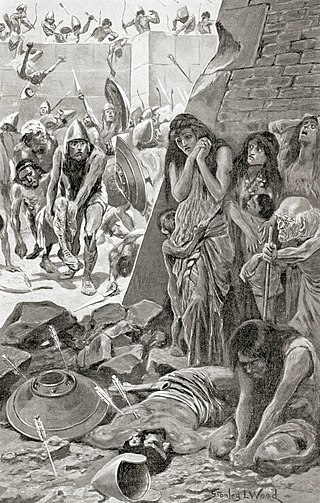
The siege of Tyre is usually assumed to have been waged for 13 years from 586 to 573 BC by Nebuchadnezzar II of Babylon. The siege of Tyre, in Phoenicia, has a significant connection to the Book of Ezekiel which in chapter 26 announces that the city will soon fall to the Babylonian forces, while chapter 29 states that the siege was partially unsuccessful. Only Josephus mentions that the siege lasted for 13 years, both in Antiquities of the Jews and in Against Apion (1.156-159). However, he dates the beginning of the siege to the 7th year of Nebuchadnezzar, which is 598/597 BC.